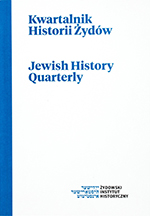Od „karaimskich” sabatajczyków do „karaimizacji” żydów rabinicznych: Pierwsza publiczna dysputa żydów na temat judaizmu w Kamieńcu Podolskim w 1757 roku (z karaimami w tle)
From „Karaite" sabbataists to „Karaimization" of rabbinical Jews: The first public disputation of Jews on Judaism in Kamieniec Podolski in 1757 (with the Karaites in the background)
Author(s): Jan DoktórSubject(s): Social history, History of Judaism
Published by: Żydowski Instytut Historyczny
Keywords: Karaites; messianism; sabbataism; frankism; Christian-Jewish disputes; Jacob Frank
Summary/Abstract: Surprisingly, it was only in the mid-18th century that the first public disputation over matters of faith in religiously divided Europe, engaged in heated dispute over religious doctrines, took place between representatives of two Jewish clans in a small town at the south-eastern corner of the Republic of Poland. It was, at the same time, the first ever public debate over the truths of faith in the Jewish world. True, disputes between the rabbanites and the Karaites have been rife since the Middle Ages, but they typically assumed the form of literary expressions, which culminated in the 12th century work entitled Sefer Kuzari by Jehuda ha-Levi. For many centuries only the Christian neophytes were publicly challenging the rabbinical orthodoxy, as they alone could afford it, thanks to the protection provided by the Church. In Kamieniec, however, facing each other were two religious formation from the Judaic camp: the dominant orthodoxy and the mystical and messianic sect of Sabbatai Zvi’s followers, which barely emerged from underground in the Republic ten-odd months earlier. Thanks to assistance from the Church, the messianists got an opportunity to present their version of the Jewish faith in writing, publicize it through print and defend it in a debate with representatives of the rabbis. For the first time in centuries the rabbis were not able to suppress the heretical movement on their own and had to face it during a public debate, hoping for a favourable ruling of the Church arbitrator. The assessment of the intentions of the Church is hampered by the absence of documentation as much as by the unexpected death of the organizer of the disputation, Kamieniec Bishop Mikołaj Dębowski, just three weeks after its conclusion. This frustrated his earlier efforts and obviously made it impossible to disclose the planned and possibly real consequences, about which we may only offer some guesses. The organizers of the disputation tried to ascribe to the sectarians two elements that were supposed to explain the support from the Church: the rejection of the Talmud (the so-called oral Torah) in favour of the written Torah (meaning, in the narrowest sense, Moses’s Pentateuch, or, more broadly, the whole Hebrew Bible), and the similarity of their teaching to that of Christianity. The case of the Karaites, which was at the background of the discussions over contra-Talmudists all the time, showed that it was not at all simple to combine anti-Talmudism with what might be termed as Christian trends. The Karaites were not famous for sympathizing with the Christians. Their literal understanding of the Scriptures ruled out both Christian and cabalistic exegesis, to which the sectarians referred. Therefore it was not possible to present the Karaites as role models to follow by contra-Talmudists, let alone contemplate the integration of both these “anti-Talmudist Jewish formations. The differences were fundamental and obvious already at first sight. When, before the Kamieniec dispute, the rabbis gave up the teaching about two Torahs and accepted the Mosaic Torah as the only received truth and groundwork of Judaism, they came closer to the Karaites than the sectarians did. From the point of view of the doctrine, the association of the new “contra-Talmudists” with the old ones, i.e., the Karaites, was uncomfortable for all the parties. The sole Karaite inspiration for the Podolia Sabbataists was the idea of legalizing their sect along the lines of the Karaite community. Talmud was evidently just a substitute topic in the dispute, although in the church strategy it was an indispensable element. It was essential for persuading the gentry and the state authorities, for whom Talmud was a key word in the Jewish question, to legalize the sect. For the Catholic clergy and probably the Polish public opinion at large as well, Talmud was part and parcel of the degeneration of rabbinism and Jewishness in general. The ruling by the consistory court legalized the new “anti-Talmudic” Jewish synagogue in the Kamieniec diocese, which was to enjoy all the rights guaranteed to the Jews”. The formation of a new synagogue with a non-Talmudic format patterned on the Karaite synagogue seemed a foregone conclusion. The death of the Kamieniec bishop a mere three weeks after the dispute interrupted the process of legalization of the sect just as it was gathering pace and ultimately frustrated it altogether.
Journal: Kwartalnik Historii Żydów
- Issue Year: 266/2018
- Issue No: 02
- Page Range: 347-383
- Page Count: 37
- Language: Polish
- Content File-PDF

